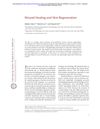3: Multimodal Molecular Analysis Reveals Divergent Trajectories Of Wound Regeneration Versus Fibrosis
July 2021
in “Plastic and reconstructive surgery. Global open”
TLDR Verteporfin treatment in mice led to complete skin healing without scarring.
The study "Multimodal Molecular Analysis Reveals Divergent Trajectories Of Wound Regeneration Versus Fibrosis" investigated the molecular events distinguishing typical scarring healing from wound regeneration induced by the drug verteporfin. The research involved C57BL/6J mice, with wounds treated with either verteporfin or a control, and samples taken at various timepoints (2, 7, 14, and 30 days post-operation). The study found that fibroblasts, a type of cell that synthesizes the extracellular matrix and collagen, followed two distinct transcriptional trajectories. One was characterized by mechanical activation and led to fibrosis (scarring), while the other was characterized by developmental and regenerative pathways leading to wound regeneration. The regenerative pathway was associated with suppression of mechanical signaling and activation of key Wnt pathway members, including Trps1, a gene with known hair follicle developmental roles. This suggests that inhibiting mechanical signaling could unlock wound regeneration and potentially offer new anti-scarring therapeutic avenues.
View this study on journals.lww.com →
Related

research Wound Healing and Skin Regeneration
Hair growth phase and certain genes can speed up wound healing, while an inflammatory mediator can slow down new hair growth after a wound. Understanding these factors can improve tissue regeneration during wound healing.